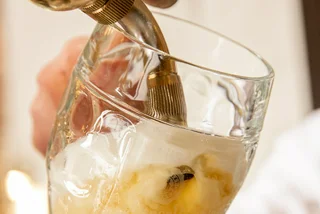As grilling season approaches, you can play it safe with the classics or explore the Czech butcher counter's lesser-known cuts. Some of these steak names, though, might sound a bit odd to the foreigner's ear (squirrel, anyone?).
And while they do have their equivalents in English, Czech butchers have historically given them some rather imaginative names. For home chefs who need a primer in the language of Czech meat, we've put together a handy reference from the experts at Prague meat meccas Naše maso and Kantýna; you can also purchase the cuts mentioned here at eshop.nasemaso.cz.
Oponka (The Curtain)
The fleshy, fibrous part of the diaphragm, known in Czech as "the curtain" (in English it's called a skirt steak) attaches to the lower ribs, sternum, and spine. When you grill it whole and slice it thinly against the grain it releases a distinctive meaty flavor. The name oponka originated during the butchering process; when the butcher breaks down the animal, the diaphragm resembles a curtain due to the small muscle that holds it to the ribs. Not just for grilling, try it in fajitas or stir-fries.
Veverka (Squirrel)
The elongated muscle referred to as the "squirrel" in Czech (hanger steak or butcher's tenderloin in English) is attached to the last rib and the spine near the kidneys. Due to its proximity to the liver, this cut has a distinct and robust flavor. These steaks love being grilled and should be grilled whole and sliced only when served on the plate.
Pavučinka (Spider Web)
Also known as the "falešná líčka" (fake beef cheeks) The "pavučinka" or "cobweb" is a tender cut from the pelvic cavity, whose fat marbling resembles a spider's web. It is a real delicacy and hard to find, though the pork version is sometimes available at Naše maso.
Holubička (Little Pigeon)
Named due to the fact that the meat resembles a pigeon's wing, in English, it's called a tri-tip steak. It's cut from the tri-tip roast, part of the bottom sirloin subprimal cut. A flavorful piece of meat it's also far less expensive than other steak cuts such as rib-eye. Holubička is also known as "the steak of the old butchers," because today's butchers aren't as familiar with it and can't portion it properly.
Malý ořech (Little Nut)
Called a rump steak in English, the little nut is also known in butcher speak as the heart of the thigh, fragile, juicy, and perfect for roasting until pink or cooked medium rare on the grill. After sirloin, it's the muscle with the most delicate taste. Ambiente restaurants use this cut to make carpaccio or tartare.
Bryndáček and zrcátko (Baby's Bib and Little Mirror)
These cuts are both parts of the navel. Bryndáček (baby's bib in Czech) is a flap steak that's a moderately marbled muscle with coarse fibers and a very distinct "bloody" flavor. It's best grilled whole on medium and also works in stews.
The zrcátko (mirror in Czech and better known in English as a flank steak) takes its Czech name from its smooth, shiny flesh and similar to the "bib" has a distinct flavor and coarse fibers and is best grilled as a whole on medium heat or medium and cut across the grain into thin strips.
In the Czech Kitchen is a weekly column written in cooperation with the culinary experts from Ambiente. Established in 1995, the Prague-based collective of pubs, restaurants, and fine-dining outlets have transformed the Czech culinary landscape and lent to the widespread awareness of quality food service and production in Czechia. Follow their socials or book your table at www.ambi.cz.












 Reading time: 3 minutes
Reading time: 3 minutes 























